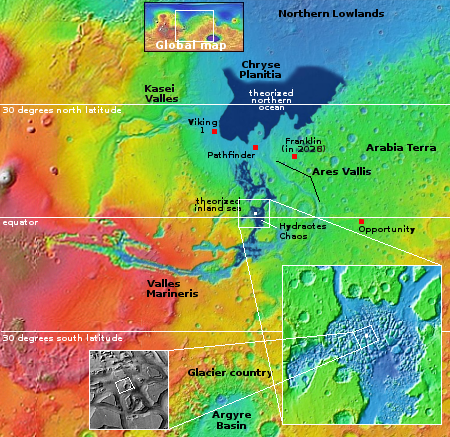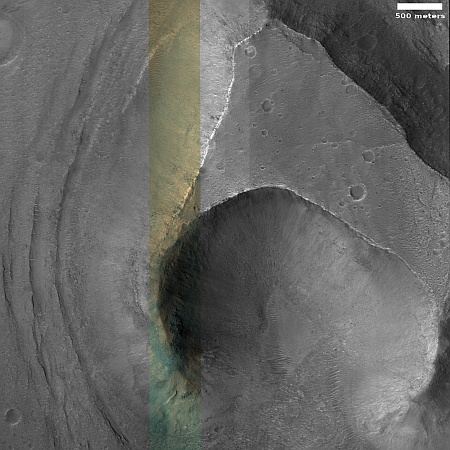Layered mesas in Martian chaos
Cool image time! The picture to the right, rotated, cropped, reduced, and sharpened to post here, was taken on May 19, 2024 by the high resolution camera on Mars Reconnaissance Orbiter (MRO). It shows a 2,500 to 3,000-foot-high mesa with what the scientists call “bedrock layers”, most obvious as the lower terraces on the mesa’s western slopes.
What makes this mesa especially interesting is its overall shape. It appears as if something has taken a bite out of it, resulting in that bowl-like hollow on the mesa’s southern half.
Was this caused by an impact? Or has some other long term Martian processes caused it?
This mesa is just one of many mesas in a region of chaos terrain dubbed Hydraotes Chaos. Such chaos terrain is thought to form when erosion processes, possibly glacial in nature, that carve out canyons along faultlines, leaving behind mesas with randomly oriented canyons cutting in many directions.

The white dot in the middle of Hydraotes Chaos markes this location, with the two insets providing views at different resolutions. The first inset shows all of Hydraotes and its chaotic landscape of endless mesas and canyons. The second inset shows the mesas more closely, and if you look close, you will notice that only this one mesa has what appears to be a circular hollow.
Thus, the crater impact that produced this hollow is one of the most recent geological events that has occurred here. No other obvious craters are visible, suggesting that the process that formed the chaos terrain wiped clean the past record of cratering. Instead, that process resulted in these terraced mesas, produced by the past presence of either ice or catastrophic floods (as suggested by the evidence of a hypothesized intermittent inland sea. Now however the only erosion likely taking place is from wind, since Hydraotes is in the dry tropics where there is little or no near surface ice.
On Christmas Eve 1968 three Americans became the first humans to visit another world. What they did to celebrate was unexpected and profound, and will be remembered throughout all human history. Genesis: the Story of Apollo 8, Robert Zimmerman's classic history of humanity's first journey to another world, tells that story, and it is now available as both an ebook and an audiobook, both with a foreword by Valerie Anders and a new introduction by Robert Zimmerman.
The print edition can be purchased at Amazon or from any other book seller. If you want an autographed copy the price is $60 for the hardback and $45 for the paperback, plus $8 shipping for each. Go here for purchasing details. The ebook is available everywhere for $5.99 (before discount) at amazon, or direct from my ebook publisher, ebookit. If you buy it from ebookit you don't support the big tech companies and the author gets a bigger cut much sooner.
The audiobook is also available at all these vendors, and is also free with a 30-day trial membership to Audible.
"Not simply about one mission, [Genesis] is also the history of America's quest for the moon... Zimmerman has done a masterful job of tying disparate events together into a solid account of one of America's greatest human triumphs."--San Antonio Express-News
Cool image time! The picture to the right, rotated, cropped, reduced, and sharpened to post here, was taken on May 19, 2024 by the high resolution camera on Mars Reconnaissance Orbiter (MRO). It shows a 2,500 to 3,000-foot-high mesa with what the scientists call “bedrock layers”, most obvious as the lower terraces on the mesa’s western slopes.
What makes this mesa especially interesting is its overall shape. It appears as if something has taken a bite out of it, resulting in that bowl-like hollow on the mesa’s southern half.
Was this caused by an impact? Or has some other long term Martian processes caused it?
This mesa is just one of many mesas in a region of chaos terrain dubbed Hydraotes Chaos. Such chaos terrain is thought to form when erosion processes, possibly glacial in nature, that carve out canyons along faultlines, leaving behind mesas with randomly oriented canyons cutting in many directions.

The white dot in the middle of Hydraotes Chaos markes this location, with the two insets providing views at different resolutions. The first inset shows all of Hydraotes and its chaotic landscape of endless mesas and canyons. The second inset shows the mesas more closely, and if you look close, you will notice that only this one mesa has what appears to be a circular hollow.
Thus, the crater impact that produced this hollow is one of the most recent geological events that has occurred here. No other obvious craters are visible, suggesting that the process that formed the chaos terrain wiped clean the past record of cratering. Instead, that process resulted in these terraced mesas, produced by the past presence of either ice or catastrophic floods (as suggested by the evidence of a hypothesized intermittent inland sea. Now however the only erosion likely taking place is from wind, since Hydraotes is in the dry tropics where there is little or no near surface ice.
On Christmas Eve 1968 three Americans became the first humans to visit another world. What they did to celebrate was unexpected and profound, and will be remembered throughout all human history. Genesis: the Story of Apollo 8, Robert Zimmerman's classic history of humanity's first journey to another world, tells that story, and it is now available as both an ebook and an audiobook, both with a foreword by Valerie Anders and a new introduction by Robert Zimmerman.
The print edition can be purchased at Amazon or from any other book seller. If you want an autographed copy the price is $60 for the hardback and $45 for the paperback, plus $8 shipping for each. Go here for purchasing details. The ebook is available everywhere for $5.99 (before discount) at amazon, or direct from my ebook publisher, ebookit. If you buy it from ebookit you don't support the big tech companies and the author gets a bigger cut much sooner.
The audiobook is also available at all these vendors, and is also free with a 30-day trial membership to Audible.
"Not simply about one mission, [Genesis] is also the history of America's quest for the moon... Zimmerman has done a masterful job of tying disparate events together into a solid account of one of America's greatest human triumphs."--San Antonio Express-News



No one is “quite sure” what they are looking at here. But they are *sure* they are looking at *earth like planets* 300 light years away. The people who buy this stuff should be too embarrassed to show their faces in public.
The same people who aren’t sure what they are seeing here are certain they are seeing “earth like planets” 300 light years away. Story in there somewhere…
Bob, I for one welcome our science-hating Overlords.
Kent Brockman
https://youtu.be/8lcUHQYhPTE
(0:48)